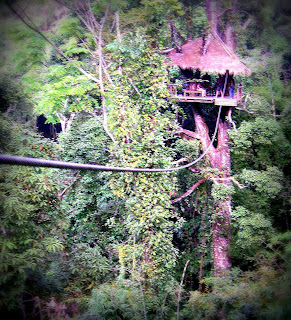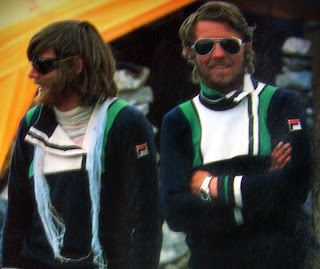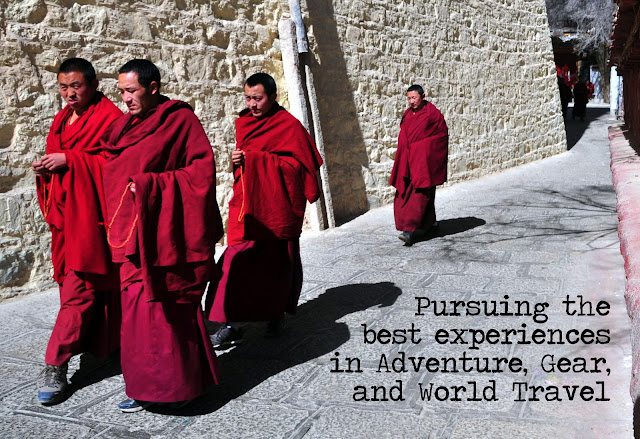This is our final post on this Blogspot page, because Get Out and Travel is moving to www.getoutandtravel.net. We will still be providing rich content and pursuing the best experiences in adventure, gear, and world travel. We hope to see you there!
Tuesday, March 19, 2013
Wednesday, March 13, 2013
Hardshell or Softshell? Get Arc'teryx's Take In Under A Minute - Video

In the 60-second video below, Arc'teryx ski mountaineering athlete Greg Hill takes a look at a softshell and a hardshell and gives the quick lowdown on optimal scenarios for each. Hill makes his point nicely and concisely by contrasting two of Arc'teryx's strongest offerings: the Gamma MX Softshell, a great piece for high output activities that we took a look at a few months ago, and the Stingray Hardshell, a bombproof jacket designed to stand up to run after run in even the nastiest mountain weather.
Do you have a specific hardshell or softshell that you swear by? We'd love to hear about it, drop us a comment.
Monday, March 11, 2013
What To Order: China - Iron Skillet Beef
Chinese cuisine is a rich tapestry of distinct regional specialities, national staples, and ethnic mainstays, ranging from delightful to surprising to hard-to-stomach. At first it can all seem overwhelming and, to some I have traveled with, wholly unappealing. However, there are so many options that finding your favorite is only a matter of the right advice and an adventurous spirit.
 |
| Chicken feet are a Chinese favorite that many visitors find hard to stomach |
Not surprisingly, each region of the country proudly declares their dishes "the best," but that is a hard-fought title that each visitor should bestow themselves. When traveling in China, my favorite dish luckily transcends regional boundaries and is widely available across the country and known by all Chinese, a dish called '铁板牛肉' (tiě bǎn niúròu) or "iron skillet beef."
Slices of tender beef sirloin are fried together with peppers, onions, and spices and presented on a sizzling iron skillet. Think: a fajita without tortillas.
While each restaurant has their own take on the dish, some choosing to include mushrooms or other vegetables as filler or using their own secret blend of spices, iron skillet beef is pretty standard across the country and is a safe bet for anyone worried of making an "exotic accident" when ordering.
Another plus for travelers hesitant to venture too far into the uncharted waters of Chinese cuisine, 铁板牛肉 (tiě bǎn niúròu) is not served with the usual blistering zest that is common in many regional dishes such as Hunan, Chongqing, Guizhou and Sichuan Cuisines.
Whether your travels take you to the Middle Kingdom or the Chinese restaurant across town, add iron skillet beef to your repertoire - you won't regret it!
Saturday, March 9, 2013
Responsible Tourism: The Right Blend of Authenticity and Sensitivity
"Interacting with local people, being part of the real lives of the locals, participating in local traditions and customs... these are some aspects of ecotourism and responsible tourism that many travelers seek, in order to find unique and authentic experiences. But are we being intrusive when we seek more local and more personal experiences? What are responsible ways of conducting tourist activities in local communities, and what's the difference between responsible and irresponsible ways?"
So begins The International Ecotourism Society's recent article on the tension between finding authentic travel experiences and being culturally sensitive.
 Being a respectful visitor should always be at the forefront of every world traveler's mind when they travel, but the challenge for many is finding a way to blend responsible travel and authentic experiences. As an outsider, it can be exceptionally difficult to identify whether the context you are stepping into (activities, guide services, political requirements for visitors, etc.) is sensitive to the prevailing social situation or not.
Being a respectful visitor should always be at the forefront of every world traveler's mind when they travel, but the challenge for many is finding a way to blend responsible travel and authentic experiences. As an outsider, it can be exceptionally difficult to identify whether the context you are stepping into (activities, guide services, political requirements for visitors, etc.) is sensitive to the prevailing social situation or not.
The key for travelers is to locate agencies that have consciously postured themselves as a positive force for change in the local community. One of the best ways we have found to navigate the murky waters of cross-cultural sensitivity is to sign on with a travel company that hires local guides, or even better, a locally owned firm. While "hiring local" is not a guaranteed way to avoid irresponsible practices, it is a good place to start.
As the Ecotourism Society's article points out, "In order for businesses and destinations to avoid exploitative forms of tourism and to be responsible and respectful, they must not only seek opportunities to engage travelers in an educational manner (for example through learning to cook local food, or participating in lessons to learn traditional craft-making), but also ensure that they are working with – and not for – the local communities."
We saw examples of this in our post on China's Yunnan province, with guiding and travel outfits using their platforms as mediums for conservation and community betterment efforts, not merely vehicles for gaining profits. Organizations such as The International Ecotourism Society and the Center for Responsible Travel can help shine light on which companies have a proven record of responsible travel practices.
Get out and travel responsibly.
Full article: How Can Travelers Find Authentic Experiences That Are Culturally Respectful and Socially Sensitive? (from The International Ecotourism Society)
So begins The International Ecotourism Society's recent article on the tension between finding authentic travel experiences and being culturally sensitive.
 Being a respectful visitor should always be at the forefront of every world traveler's mind when they travel, but the challenge for many is finding a way to blend responsible travel and authentic experiences. As an outsider, it can be exceptionally difficult to identify whether the context you are stepping into (activities, guide services, political requirements for visitors, etc.) is sensitive to the prevailing social situation or not.
Being a respectful visitor should always be at the forefront of every world traveler's mind when they travel, but the challenge for many is finding a way to blend responsible travel and authentic experiences. As an outsider, it can be exceptionally difficult to identify whether the context you are stepping into (activities, guide services, political requirements for visitors, etc.) is sensitive to the prevailing social situation or not.The key for travelers is to locate agencies that have consciously postured themselves as a positive force for change in the local community. One of the best ways we have found to navigate the murky waters of cross-cultural sensitivity is to sign on with a travel company that hires local guides, or even better, a locally owned firm. While "hiring local" is not a guaranteed way to avoid irresponsible practices, it is a good place to start.
 |
| Ziplining and other ecotourism activities can bring a huge boost to local communities |
We saw examples of this in our post on China's Yunnan province, with guiding and travel outfits using their platforms as mediums for conservation and community betterment efforts, not merely vehicles for gaining profits. Organizations such as The International Ecotourism Society and the Center for Responsible Travel can help shine light on which companies have a proven record of responsible travel practices.
Get out and travel responsibly.
Full article: How Can Travelers Find Authentic Experiences That Are Culturally Respectful and Socially Sensitive? (from The International Ecotourism Society)
Thursday, March 7, 2013
Altitude Sickness: Lessons Learned At 12,000ft. (Part 1)
A couple of weeks ago, after two months of traveling in Europe and Southeast Asia, I finally returned home to my perch at 12,000ft. in the mountains, just as I have done many times before. And just like every time before, I jumped right back into life, not giving it a second thought.
Later that evening as I headed to bed for the night, 12 hours or so after getting back, I felt myself physically wither - I started to feel a dull-but-intense headache, my joints and muscles began to ache so that I just could not find a way to lie comfortably, and I oscillated between being too hot and too cold.
I know that altitude-related symptoms can affect anyone who does not take time to adequately acclimatize no matter their level of physical conditioning, but since I had never experienced symptoms before and had maintained an active lifestyle during my travels, even traveling as high as 10,000ft. while in Europe, I honestly did not expect it to affect me when I returned.
In light of my recent humbling experience, this post will look at some ways that the NOLS Wilderness Medicine Institute and the non-profit group The Mountaineers recommend preventing altitude illness, with a follow up post to discuss assessing and treating altitude illness in the field.
Later that evening as I headed to bed for the night, 12 hours or so after getting back, I felt myself physically wither - I started to feel a dull-but-intense headache, my joints and muscles began to ache so that I just could not find a way to lie comfortably, and I oscillated between being too hot and too cold.
 |
| Reinhold Messner and Peter Habeler were the first to reach Everest's 29,029ft. summit without the aid of supplemental oxygen. They took 3 months to acclimatize and summit. |
At first I thought I was coming down with the flu, but soon realized that I was coming up against something I had never experienced in all of my time spent at high altitude: altitude sickness, or more correctly, altitude illness.
According the NOLS Wilderness Medicine Handbook, altitude illness "results from insufficient oxygen in the blood (hypoxia) secondary to decreased barometric pressure at altitude."
I know that altitude-related symptoms can affect anyone who does not take time to adequately acclimatize no matter their level of physical conditioning, but since I had never experienced symptoms before and had maintained an active lifestyle during my travels, even traveling as high as 10,000ft. while in Europe, I honestly did not expect it to affect me when I returned.
In light of my recent humbling experience, this post will look at some ways that the NOLS Wilderness Medicine Institute and the non-profit group The Mountaineers recommend preventing altitude illness, with a follow up post to discuss assessing and treating altitude illness in the field.
Tuesday, March 5, 2013
"Into the Mind" - An Upcoming Film From The North Face
Later this fall, The North Face and Sherpas Cinema will debut their upcoming film "Into The Mind," which looks to be a simultaneous exposé on the factors that drive us into the mountains in search of adventure and the cultures that call those mountains home.

Resolving to explore as much of the philosophical as the aesthetic, the film's website ventures the questions: "What drives us to overcome challenge? How do we justify risk? What forces are at the core of a mountain addiction?"
The footage in the trailer is truly spectacular, showing a mix of pristine mountain environs, a slew of The North Face's athletes in action, and the mystique of Himalayan life. Per the website, "Unique athlete segments over a multitude of mountain sport genres, depict the connectivity of Earth and window into never seen before moments."
There are a lot of big-name sponsors attached to the film in addition to The North Face, including GoPro, Recco, Black Diamond, Arc'teryx, and Mammut, so there's no doubt that "Into The Mind" will be an experience worth waiting for.

Resolving to explore as much of the philosophical as the aesthetic, the film's website ventures the questions: "What drives us to overcome challenge? How do we justify risk? What forces are at the core of a mountain addiction?"
The footage in the trailer is truly spectacular, showing a mix of pristine mountain environs, a slew of The North Face's athletes in action, and the mystique of Himalayan life. Per the website, "Unique athlete segments over a multitude of mountain sport genres, depict the connectivity of Earth and window into never seen before moments."
There are a lot of big-name sponsors attached to the film in addition to The North Face, including GoPro, Recco, Black Diamond, Arc'teryx, and Mammut, so there's no doubt that "Into The Mind" will be an experience worth waiting for.
Sunday, March 3, 2013
MSR Reactor Stove Grabs Top Award At 2013 ISPO - Video
 |
| MSR's award winning Reactor 1.0L Stove System |
While the Reactor 1.0L Stove System is new to the market, Mountain Safety Research (MSR) is well known and respected among guides and outdoor adventurers. According to a review by Alpinist magazine, "MSR has long made the stoves favored by guides... MSR's Reactor is by far the best. In my experience, the Reactor reduces my fuel needs by 50 percent." Another review, by Outdoor Gear Lab, calls the Reactor, "the fastest, easiest to use, and most storm-proof camping stove we tested."
The following video is from Outdoor Gear Lab's review of the Reactor Stove:
MSR's Reactor Stove Systems includes the new, IPSO award-winning 1.0L system, a 1.7L system, and a 2.5L system, all of which are highly praised. Benefits that MSR claims of their Reactor Stoves include:
- Unrivaled Boil Time: Outperforms the competition in head-to-head lab tests—boiling .5 liter of water in just 1.5 minutes—with an even greater advantage out in the real world.
- Unmatched Wind Protection: Heat exchanger completely encloses radiant burner head, virtually eliminating the effects of wind to maintain outstanding boil times and save fuel.
- Maximum Efficiency: Patent-pending radiant burner, heat exchanger and internal pressure regulator produce best-in-class, fuel-sipping efficiency in all conditions.
For full reviews of MSR's Reactor Stoves, check the following:
Friday, March 1, 2013
Air Travel Health Tips: Fact vs. Fiction - Video
Getting sick when you travel is a bummer, and nothing stings worse then picking up a bug on your way to your destination. Coincidentally, there are a lot of myths about the role air travel can play in disease transmission.

The key to healthy travel, especially when air travel will be involved, is identifying misinformation and making wise choices. In the video link below, the Chief of Medicine at MIT Medical walks through some basic misconceptions about air travel health and gives a few pointers on how to protect yourself from contracting diseases en route.
Did we choose this video because of the vintage airline footage? Maybe. Did the cheesy role-playing cement our choice? Possibly. Is the amount of emphasis put on portable hand sanitizer pretty comical? Definitely.
All of that notwithstanding, when the Chief of Medicine at MIT talks, we usually listen.
On a related note, travel medical insurance might be a good idea if you are flying to an adventure somewhere off the beaten path. Oh, and don't forget your hand sanitizer.

The key to healthy travel, especially when air travel will be involved, is identifying misinformation and making wise choices. In the video link below, the Chief of Medicine at MIT Medical walks through some basic misconceptions about air travel health and gives a few pointers on how to protect yourself from contracting diseases en route.
Did we choose this video because of the vintage airline footage? Maybe. Did the cheesy role-playing cement our choice? Possibly. Is the amount of emphasis put on portable hand sanitizer pretty comical? Definitely.
All of that notwithstanding, when the Chief of Medicine at MIT talks, we usually listen.
On a related note, travel medical insurance might be a good idea if you are flying to an adventure somewhere off the beaten path. Oh, and don't forget your hand sanitizer.
Subscribe to:
Comments (Atom)


